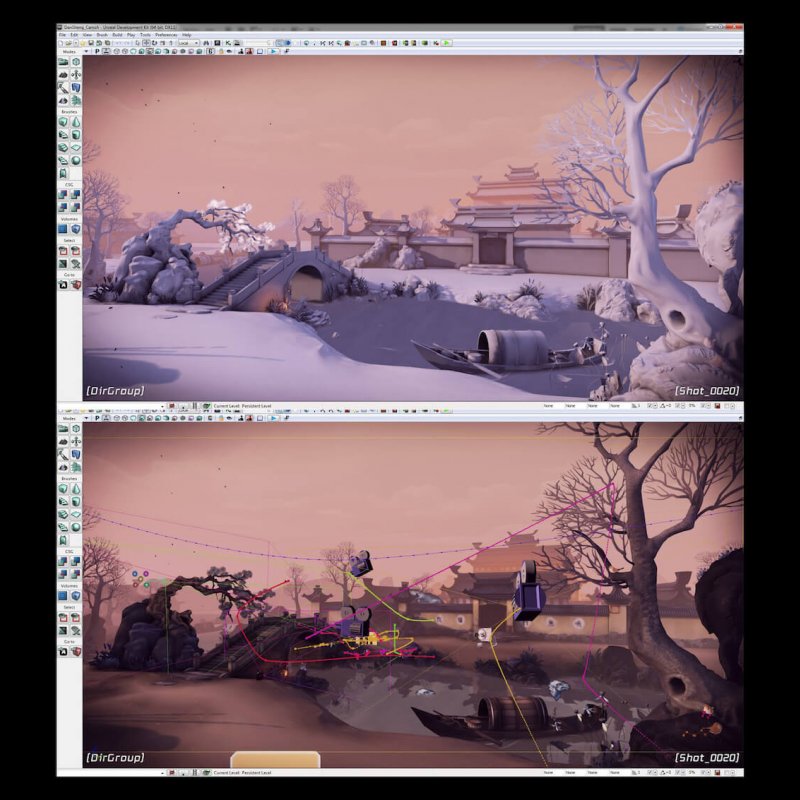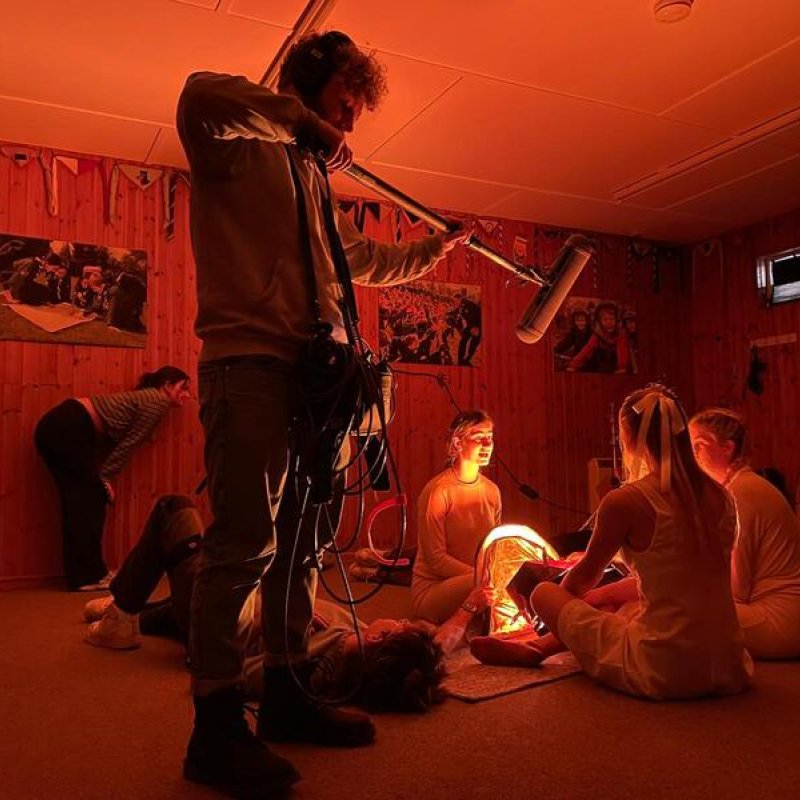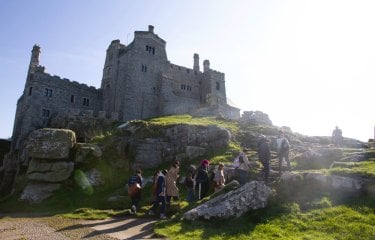A guide to Worldbuilding

Work by Nathan Bedford
Far more than mere backdrop, well-crafted worldbuilding shapes the sights, sounds, and experiences that draw audiences into a new universe, adding layers of context and coherence. At Falmouth University, worldbuilding is integral to many creative courses, especially at the Games Academy, where students learn to create vivid, engaging worlds for interactive media that invite players to explore, interact, and immerse themselves fully.
In this article, we caught up with William Pryn, Senior Lecturer in the Games Academy, to learn how to bring these imaginative worlds to life.
What is worldbuilding?
Worldbuilding is the creation of the deeper setting or backdrop for fictional work such as a film, novel or video game. This fictional world, built up around the audio-visual experience, complements everything that we see, hear and experience but also serves to enrich and deepen that experience.
To give some examples; this could take the shape of detailed historical lore such as that in Lord of the Rings or World of Warcraft, or it could be differing physical laws that affect the world such as in the game Portal. The geography of a world, architecture, languages and even social laws and structure all contribute to the worldbuilding and backdrop to the main experience.
Worldbuilding is this manipulation of the immersive experience to provide a deep and consistent setting to the story. This can be in small ways such as distorting the reality of the existing world or on a macro scale, creating an entirely new universe for the player or viewer. J. R. R. Tolkien described worldbuilding as creating "enchantment" in his readers, in this sense you could say we are casting a delicate spell over our target audience.

What are the different types of worldbuilding?
Worldbuilding can be approached in various ways depending on the needs of the story, game, or project. There are, however, two main types of worldbuilding that can be applied to any project – hard worldbuilding and soft worldbuilding.
Hard worldbuilding
Hard worldbuilding is highly detailed, with well-defined rules and an extensive lore that explains how the world within the chosen medium operates. Detailed rules and traditions described in this method might include magic, technology, history, social structures and even languages. There is an explanation for everything, and this provides a resilience to narrative inconsistency.
J.R.R. Tolkien’s Middle-earth is a prime example of hard worldbuilding, with a well-defined history, languages, races, and geography. In science fiction, Star Trek features a hard sci-fi world with detailed scientific explanations of space travel, ethics, resource distribution, and politics.
Soft worldbuilding
Soft worldbuilding involves a certain level of ambiguity and uncertainty to the audience by limiting the amount of information available in a way to encourage an imaginative ‘filling of the gaps’ in their mind.
An example of soft worldbuilding can be seen in The Legend of Zelda: Breath of the Wild, which provides a sense of history and depth but does not explain every detail of Hyrule’s past. Likewise, Studio Ghibli’s Princess Mononoke features a richly imaginative world but leaves many of the magical elements unexplained, adding to a sense of wonder.

How is worldbuilding used across different industries?
Worldbuilding plays a vital role across multiple industries, such as game design, creative writing, film, and animation, but its approach and focus vary depending on the medium. In games, worldbuilding often centres on interactivity but is complemented by other aspects such as narrative, character, music and environment design. In film and animation, worldbuilding is focused on visual and audio immersion, and in creative writing worldbuilding is used as a tool for narrative depth, dialogue and descriptive detail.
Regardless of the medium or industry, worldbuilding serves to create believable and engaging universes that draw the target audience into the story.
Tips to guide the worldbuilding process
Worldbuilding might be crafted in differing ways dependant on the discipline, be it narrative, music, design, architecture or history but there are common threads that underpin it all; story, research and iteration.
Prioritise the plot
The story or idea should always come first, the surrounding world is meant to support the story of the game, film or novel - not overshadow it. No matter how richly detailed the world may be, a compelling plot and engaging characters are essential to capture the audience's interest. The very first question a player will ask when they sit down to play a game is ‘who and where am I? what am I doing?’. Worldbuilding and storytelling must work together in harmony to provide consistency and strength of experience.
Do your research
Research forms the foundation of compelling worldbuilding, adding realism, depth, and coherence to fictional worlds. By drawing on real-world knowledge, historical examples, and cultural insights, research enriches nearly every aspect of worldbuilding.
To give an example, when writing the A Song of Ice and Fire series, the author George R. R. Martin heavily researched the Wars of the Roses – a period of civil war fought over control of the English throne from 1455 to 1485. This historical backdrop provided him with a vivid, bloody inspiration and grounded sense of reality, offering insights into the complex dynamics of political power struggles that helped him to craft his story with such gritty detail.
Research extends to many other areas as well, for instance, studying your target audience will reveal a lot about the expectations of the average consumer within your chosen genre. An arcade-style couch co-op game for 6–10-year-olds would be very different to an 18+ high-fantasy game, in both style and content.
Use an iterative design process
Drafting and redrafting is essential to any project that aims to create an immersive world. An iterative design process, where the concept is continuously refined and improved upon through repeated cycles of testing, evaluation, and modification, will allow the creators to refine their ideas, strengthen storytelling, and polish the final product.
George R. R. Martin would have re-written and edited passages multiple times before submitting his novels to an editor, ensuring the story is communicated clearly and consistently while capturing the depth of immersion he aimed to create for readers.
At Falmouth University’s Games Academy, the concept of iteration is central to our creative process. We create multiple design variations, gathering feedback from team members and peers before developing a selected concept into a 3D prop, playable character, or splash art. Throughout this process, we apply a critical eye, rigorously evaluating what aligns with the project’s vision and what might need to be discarded. Regular feedback helps us refine our work toward the final piece—though this process can be challenging! Prepare to "kill your darlings" and let go of ideas that don’t quite fit.
How is worldbuilding taught at Falmouth University?
Worldbuilding is a key element across many courses at Falmouth, reflecting its importance in the creative industries – from creative writing and illustration to film, game art and more.
At the Games Academy, worldbuilding is especially crucial, as video games offer players a uniquely immersive and participatory experience rather than a passive one. Players expect to explore environments, interact with objects and characters, and uncover details that make the world feel alive. This dynamic engagement is more akin to an interactive opera than any other narrative form, and a shallow or underdeveloped world can make or break the player's experience. Games Academy students learn worldbuilding from industry veterans with decades of experience, benefiting from insights into crafting truly immersive and memorable game worlds.

Examples of worldbuilding in games
Falmouth students have developed fantastic examples of in-depth worldbuilding, producing some epic games that deliver truly unique and entertaining experiences. The game Planetary Pest Control showcases a cohesive and immersive world. The game’s striking visuals, unique gameplay, technology and engaging narrative combine to offer players an exciting journey across distant planets, eradicating alien infestations.
Another standout game, Dr Bounce is a chaotic blend of first-person shooter and pinball. The game’s unique visuals and mechanics compliment one-another, delivering a hugely entertaining experience where the player must bounce their way through a slime-infested lab on a mission to save their mother.
Trailer for the video game, Planetary Pest Control
Trailer for the video game, Dr Bounce
In the creative industries, effective worldbuilding can transform a simple story into a rich experience, making it essential for aspiring creators to understand the principles of worldbuilding. From research to iterative design, the worldbuilding process blends art, storytelling, and technical skill.
At Falmouth University’s Games Academy and across other creative courses, students are taught to bring these imaginative worlds to life, guided by seasoned professionals from the industry. Whether you’re passionate about making your own games, films or novels, Falmouth offers an ideal environment to develop your worldbuilding skills. Discover how Falmouth can help you build worlds of your own—explore our courses today.
Lead image: Nathan Bedford




